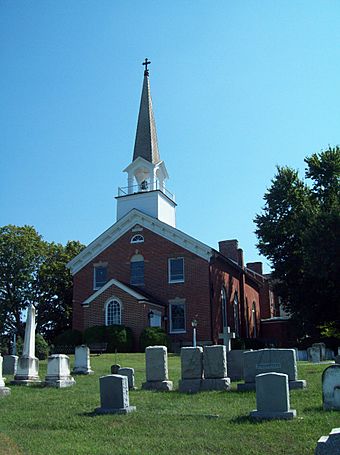St. Thomas Manor facts for kids
Quick facts for kids |
|
|
St. Thomas Manor
|
|

St. Ignatius Church at St. Thomas Manor, September 2009
|
|
| Location | Maryland Route 427/Chapel Point Rd., Port Tobacco |
|---|---|
| Area | 10.7 acres (4.3 ha) |
| Built | 1741 |
| Architectural style | Georgian |
| NRHP reference No. | 88002050 |
| Added to NRHP | November 10, 1988 |
St. Thomas Manor is a very old and important historic site located near Port Tobacco, Charles County, Maryland. It includes a historic home and a Catholic church. This special place is also known as St. Ignatius Church and Cemetery. It is famous for being the oldest home where Jesuit priests have lived continuously anywhere in the world!
The story of this area began in 1641. That's when Father Andrew White, an English Jesuit missionary, started a mission settlement called Chapel Point. Father White worked with the Potapoco Native Americans living there. He helped some of them learn about and join the Catholic faith. The church here, established in 1662, is the oldest Catholic parish that has been active without stopping in the American Thirteen Colonies. In 1794, Bishop John Carroll became the first Catholic bishop in the United States right here at St. Thomas Manor. This made St. Thomas the first main center for the Catholic Church in the country.
Contents
What is St. Thomas Manor Like?
The main house at St. Thomas Manor is a two-story brick building. It was built in 1741 in a style called Georgian architecture. This style was popular in England during the time of King George. The manor house is the oldest example of this building style still standing in Maryland. It was built to be the main office for the Jesuit priests in Maryland. It replaced an older building that was there before. This house was also a central point for other Jesuit missions in Maryland and the mid-Atlantic region.
The Church and Other Buildings
Next to the manor house is a two-story brick part that used to be a chapel built in 1798. Today, this part is known as St. Ignatius Church. There are also other important buildings on the property. One is a small wooden building from the mid-1800s that was once a home for enslaved people. It's one of the few buildings like it that still exists in this area. Another building, which used to store corn, is the largest of its kind found in Charles County. It has many unique building features.
The Cemetery
To the west of the manor house and church, there is a cemetery. Many important people are buried there. These include Confederate agent Olivia Floyd, a kind person from La Plata named Adrian Posey, judge Walter M. Digges, and U.S. Congressmen Sydney Emanuel Mudd and Sydney Emanuel Mudd II.
St. Thomas Manor was added to the National Register of Historic Places in 1988. Because of its long history and beautiful location by the water, many people visit the manor grounds, church, and cemetery. It's also a popular stop for bicycle tour groups.
Important Moments in History
In 1794, a very important event happened at St. Thomas Manor. John Carroll put on his special robes here to become the first Catholic bishop of the United States. This happened after the country became independent in the Revolutionary War. (He later traveled to London to be officially made a bishop.) This event made St. Thomas the first official center for the Catholic Church in the United States.
The Return of the Jesuits
The St. Thomas complex was also where the Jesuit order started up again in the United States in 1805. The Catholic Church had stopped the Jesuit order in 1773. But at St. Ignatius Church, three American priests took their vows, bringing the Jesuits back to the country.
Enslaved People at St. Thomas Manor
Some of the enslaved people owned by the Jesuit Maryland Province lived at St. Thomas Manor. These individuals were later moved in 1838. The Jesuits in Maryland did not support the slave trade, but they did practice slavery.
Catholic Church Records and Native Americans
During the time of slavery and after the American Civil War, many governments in the southern United States only recorded people as either Black or White. However, St. Ignatius Church was one of the Catholic parishes that continued to record its Native American members as "Indian." This was true even if they were of mixed race. In other historical records, the tribal identities of some Native Americans were lost. This happened when people from outside their communities classified them as "free people of color," "colored," or "white," no matter how they saw themselves. Researching these Catholic records has helped some tribes prove their long cultural history and their identity as Native Americans. This has helped them gain official recognition as tribes from states and the federal government since the late 1900s.
Gallery
See also
- List of Jesuit sites







